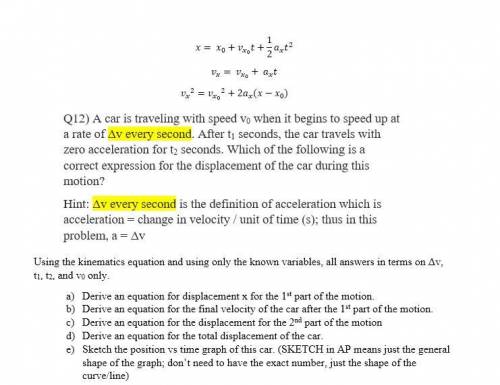
Physics, 17.11.2020 02:10 gamergladiator43
Q12) A car is traveling with speed v0 when it begins to speed up at a rate of Δv every second. After t1 seconds, the car travels with zero acceleration for t2 seconds. Which of the following is a correct expression for the displacement of the car during this motion?
Hint: Δv every second is the definition of acceleration which is acceleration = change in velocity / unit of time (s); thus in this problem, a = Δv
Using the kinematics equation and using only the known variables, all answers in terms on Δv, t1, t2, and v0 only.
a) Derive an equation for displacement x for the 1st part of the motion.
b) Derive an equation for the final velocity of the car after the 1st part of the motion.
c) Derive an equation for the displacement for the 2nd part of the motion
d) Derive an equation for the total displacement of the car.
e) Sketch the position vs time graph of this car. (SKETCH in AP means just the general shape of the graph; don’t need to have the exact number, just the shape of the curve/line)


Answers: 2


Another question on Physics

Physics, 22.06.2019 10:00
One object has a mass of 1 kg and another object has a mass of 3 kg. if the speeds are the same, which of the following is true about their kinetic energy?
Answers: 2

Physics, 22.06.2019 13:00
Aplayground merry-go-round has a radius of 4.6 m and a moment of inertia of 200 kg-m2 and turns with negligible friction about a vertical axle through its center. a child applies a 26.0 n force tangentially to the edge of the merry-go-round for 15.0 seconds. if the merry-go-round is initially at rest, how much work did the child do on the merry-go-round?
Answers: 1

Physics, 22.06.2019 13:50
Two students, each riding bicycles, start from the same apartment building and ride to the same building on campus, but each takes a different route. the first student rides 1100 m due east and then turns due north and travels another 1430 m before arriving at the destination. the second student heads due north for 1930 m and then turns and heads directly toward the destination.at the turning point, how far is the second student from the destination?
Answers: 3

Physics, 22.06.2019 18:20
Object a has a length of 3 cm, a width of 2 cm, and a height of 4 cm. object b is dropped into a graduated cylinder. it displaces 19 ml of water. the volume of object a is: a: greater than the volume of object b b: less than the volume of object b c: equal to the volume of object b
Answers: 2
You know the right answer?
Q12) A car is traveling with speed v0 when it begins to speed up at a rate of Δv every second. After...
Questions



Health, 02.02.2021 02:50







Mathematics, 02.02.2021 02:50







Computers and Technology, 02.02.2021 02:50



Biology, 02.02.2021 02:50




